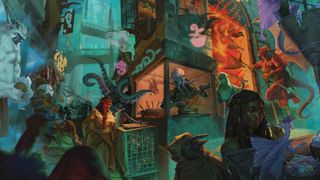If you thought Baldur's Gate 3 was wild, wait until you see the new D&D set
Welcome to Sigil, the strangest place you'll ever visit in D&D

Planescape for D&D is weird. Actually, that's the point. Traditional fantasy takes one look at it before turning around on its heel and wandering off for something more sensible.
With Planescape: Adventures in the Multiverse bearing down on us in October, we caught up with the team behind it during Gen Con 2023 to see just what the hell is going on with what is arguably one of the most bizarre settings in D&D.
Into the D&D-verse

If you're new to Planescape, forget everything you know about Dungeons and Dragons books for a second. Created in the '90s and relegated to cult-classic status after the setting was dropped (though a certain video game of the same name kept its legend alive), this isn't your average swords-and-sorcery world. As designer and Planescape lead Wes Schneider describes it, the setting is cut from the same cloth as stories like "Doctor Who, or Everything Everywhere All at Once, or Loki… this is mind-bending impossibility, tampering with what we know as the laws of reality, and shattering them."
Basically, Planescape revolves around a city called 'Sigil' that squats at the center of the D&D multiverse. However, this isn't your standard-issue medieval city. Instead, it's more like the Citadel from Mass Effect; it's a floating ring with a thriving metropolis running along the inside. It's also a nexus point that can take you anywhere. It's known as the 'City of Doors' for good reason; it's littered with portals to every setting in the Dungeons & Dragons franchise. Schneider describes Sigil as "the ultimate hub. It's any adventure you want to have literally anywhere in D&D. Any place else you can imagine is one step away."

You'll find people from almost every world imaginable on Sigil, and this hodgepodge of culture means that tensions can run high. To keep everything ticking over nicely, a mysterious, near-godly figure known as the 'Lady of Pain' maintains order. Find yourself up against impossible odds or in a fight with overwhelming foes? She may arrive to restore peace... by any means necessary.
For senior designer Jason Tondro, this allows players to transition between settings without having to tear up what's come before.
"If I'm running like my own home group, and we've been playing for a while, maybe things are a little stale, or they've hit that level where they're ready to start traveling to other worlds and other planes," he says. "I can give them access to everything without trashing that current campaign or having to start a new one… it intersects seamlessly within your home groups in your home settings."
This freedom helped Planescape catch fire back when it launched in the '90s, and a certain video game of the same name didn't hurt its popularity. But a lot has changed in the decades since. Why bring back the setting now? In a nutshell, it's because we're ready for it - over the last few years, pop culture has made 'the multiverse' a household name.
Sign up to the GamesRadar+ Newsletter
Weekly digests, tales from the communities you love, and more
These things that might have been fringe concepts several decades ago are now mainstream
Wes Schneider, Planescape lead
"25 years ago, I don't think you could have gone to somebody who wasn't immersed in nerd culture and asked about the multiverse and have them give you a solid answer," Schneider says. "Our collective imaginations evolve over time, our stories evolve over time. These things that might have been fringe concepts several decades ago are now mainstream, or some of the biggest Oscar winners in history. So that was all brewing as we wanted to start working on this - the concept of a multiverse, different planes, traveling between realms. This is something that is not fringe fantasy anymore."
Anywhere and everywhere

What separates Planescape from 2020's Radiant Citadel, though? Those adventures also revolved around a city that could lead to different universes, so are they not stepping on each others' toes? For Schneider (who also worked on that book), it's about scale.
"The primary distinction between the two of them is, Radiant Citadel is built very much to be a curated experience," he explains. "You can build this really tight framework, and then constantly have a home that you get to know. It's a much more intimate, much more curated experience… Sigil is like, where do you want to go today? Anywhere? OK, we're up for anything."

Sigil floats atop a great spire at the center of the Outlands, a confusing kingdom where influences from other realms seep in. Tondro describes it as a "fantastic campaign setting [where] you could run an entire game just running around different places in the Outlands... the planes all kind of converge and start infringing on that area."
That kind of creative freedom allows for some truly weird and wonderful combinations. As noted by game designer Makenzie De Armas, Sigil being a meeting point between worlds leads to more than a few interesting mashups.
"I'm someone who likes to take pieces of things and port them to other things," she says. "My favorite thing I'm looking forward to in Planescape is the rules you have for making creatures flavored with all the different planes. Like, a unicorn that's flavored by the Nine Hells, or reversely, a pit fiend that's been flavored by one of the upper planes."
For the team, these inhabitants are a significant part of what makes Planescape interesting. What does living here do to a person, and what's life like for them? This led to an emphasis on factions that operate throughout the city… though they may not be the same ones Sigil veterans remember. Even though there are plenty of Easter eggs to be found, the political landscape has evolved.
The exciting part of the setting is not just that anything could come through that door, or you can go through a door and be anywhere, but as a DM
Wes Schneider, Planescape lead
"From a 2023 perspective, some things still work," says Schneider. "Some things, not so much. So definitely, we've made some adjustments to what some of the factions are, we've combined some of them, we've changed some of their core philosophies, so on and so forth. So for example, we have one new faction called the Hands of Havoc, which is sort of the combination of freedom fighters, but then also anarchists. They're more about tearing down the old and creating a space for something better, which I think that, definitely in the 21st century, resounds in a way perhaps that it didn't in the '90s… Then we have other factions where they're still there, but they perhaps don't hold the same influence."
After a year of more traditional quests (like the heist-themed escapades of Keys from the Golden Vault or Phandelver and Below, a campaign that builds on classic fantasy themes), all this sounds like it's going to be a breath of fresh air with which to close out 2023. Considering how popular the equally left-field D&D video game Baldur's Gate 3 has been, there certainly seems to be a taste for the unexpected. Perhaps now really is the time, as Schneider puts it, for something "mind-bendingly wild."
For recommendations on what to play next, take a look at our guide to the best tabletop RPGs.

As the site's Tabletop & Merch Editor, you'll find my grubby paws on everything from board game reviews to the latest Lego news. I've been writing about games in one form or another since 2012, and can normally be found cackling over some evil plan I've cooked up for my group's next Dungeons & Dragons campaign.
Most Popular




